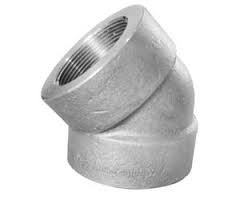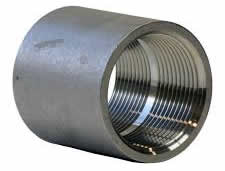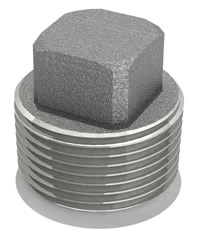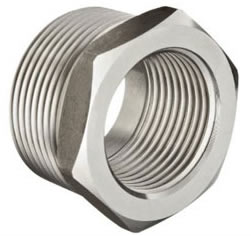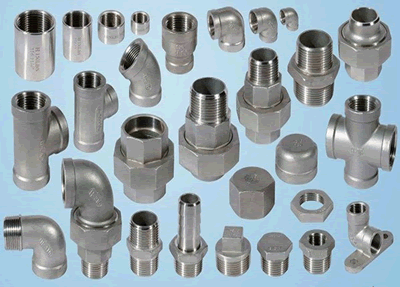
Forged Steel Pipe Fitting
What is a forged steel pipe fittings?
Forged steel pipe fittings are hot formed sections with different types for high pressure pipe fittings, they are made from the process of forging.
These fittings normally attached to pipes to the end of pipes, fittings,or other objects to connect the piping systems with different methods of joining that is by screwed or socket weld. They are available in three pressure ratings: 3000lbs, 6000lbs and 9000lbs.
The forged steel pipe fittings are mainly divided to two types in the connecting way.Socket welding pipe fitting and threaded pipe fitting.
What is the socket weld pipe fitting ?
A socket weld pipe fitting is a pipe accessory in which a pipe is inserted into a recessed area of a fitting or flange for welding.
Comparing the butt weld pipe fittings, socket weld pipe fittings are mainly used for small pipe diameters ;commonly for piping of diameter less than 4 inch. Socket-welded joints construction is a good choice when high leakage integrity and great structural strength are important in the piping design .
Socket welding fatigue resistance is lower than the butt weld construction due to the use of fillet welds , but it is still better than most of the other mechanical joining methods.
Fittings for socket weld pipe systems:
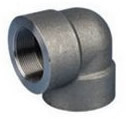 |
|
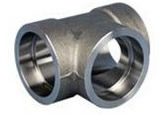 |
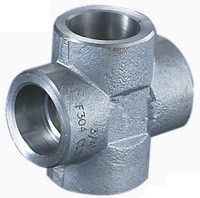 |
|
This elbows make 90° changes of direction in the run of pipe.
|
This elbows make 45° changes of direction in the run of pipe.
|
This tee makes 90° branch from the main run of pipe.
|
Crosses makes 90° branch from the main run of pipe.
|
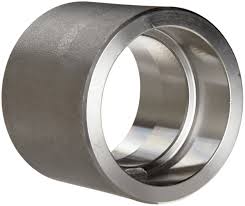 |
|
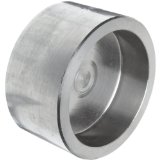 |
|
A full coupling, joins pipe two pipe or to a pbe nipple etc.
|
The half coupling can be directly welded to the run pipe, to make a branch connection.
|
Seals the threaded end of pipe.
|
Advantages
1. The pipe need not be beveled for weld preparation.
2. Temporary tack welding is no needed for alignment, because in principle the fitting ensures proper alignment.
3. The weld metal can not penetrate into the bore of the pipe.
4. They can be used in place of threaded fittings, so the risk of leakage is much smaller.
5. Radiography is not practical on the fillet weld; therefore correct fitting and welding is crucial. The fillet weld may be inspected by surface examination, magnetic particle (MP), or liquid penetrant (PT) examination methods.
6. Construction costs are lower than with butt-welded joints due to the lack of exacting fit-up requirements and elimination of special machining for butt weld end preparation.
Disadvantages
1. The welder should ensure for a expansion gap of 1/16 inch (1.6 mm) between de pipe and the shoulder of the socket. ASME B31.1 para. 127.3 preparation for welding (E) socket weld assembly says: In assembly of the joint before welding, the pipe or tube shall be inserted into the socket to the maximum depth and then withdrawn approximately 1/16″ (1.6 mm) away from contact between the end of the pipe and the shoulder of the socket.
2. The expansion gap and internal crevices left in socket-welded systems promotes corrosion and make them less suitable for corrosive or radioactive applications where solids buildup at the joints may cause operating or maintenance problems. Generally require butt welds in all pipe sizes with complete weld penetration to the inside of the piping.
3. Socket welding are unacceptable for ultrahigh hydrostatic pressure in food industry application since they do not permit full penetration
and leave overlaps and crevices that are very difficult to clean, creating virtual leaks.
The purpose for the bottoming clearance in a socket weld is usually to reduce the residual stress at the root of the weld that could occur during solidification of the weld metal, and to allow for differential expansion of the mating elements.
What is the threaded pipe fitting ?
Threaded pipe fittings : Threaded joints probably represent the oldest method of joining piping systems. Like socket weld pipe fittings, threaded pipe fittings are mainly used for small pipe sizes,commonly for piping whose nominal diameter is NPS 2 or smaller.
The dimensional standards for taper pipe threads are as per ASME B1.20.1. That standard gives all required dimensions including number of threads per inch, pitch diameter, and normal engagement lengths for all pipe diameters.
Threaded piping is commonly used in low-cost, noncritical applications such as domestic water, fire protection, and industrial cooling water systems.
Fittings for threaded pipe systems:
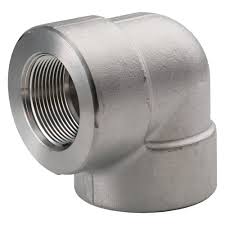 |
|
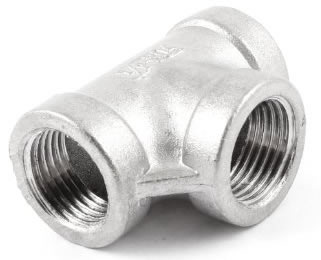 |
|
This elbows make 90° changes of direction in the run of pipe.
|
This elbows make 45° changes of direction in the run of pipe.
|
This tee makes 90° branch from the main run of pipe.
|
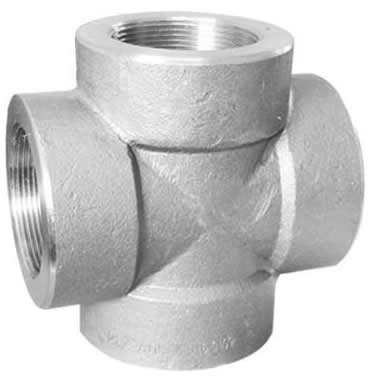 |
|
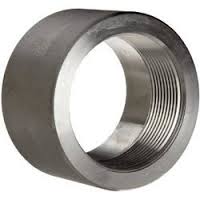 |
|
Crosses makes 90° branch from the main run of pipe.
|
A full coupling, joins pipe two pipe or to a nipple etc.
|
The half coupling can be directly welded to the run pipe, to make a branch connection.
|
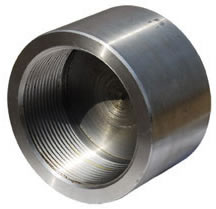 |
|
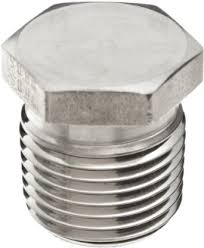 |
|
Seals the threaded end of pipe.
|
Seals the threaded end of fitting.
|
Seals the threaded end of fitting.
|
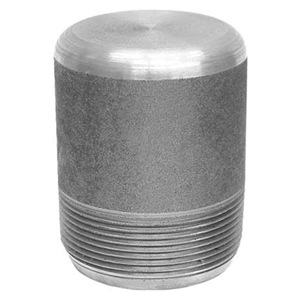 |
|
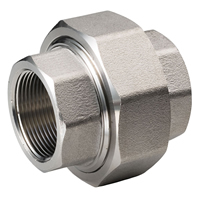 |
|
Seals the threaded end of pipe.
|
Seals the threaded end of fitting.
|
Unions are primarily used for maintenance and installation purposes.
|
Advantages
1.Installation productivity is moderately high, and specialized installation skill requirements are not extensive.
2.Leakage integrity is good for low-pressure, low-temperature installations where vibration is not encountered.
Disadvantages
1.Rapid temperature changes may lead to leaks due to differential thermal expansion between the pipe and fittings.
2. Vibration can result in fatigue failures of screwed pipe joints due to the high stress intensification effects caused by the sharp notches at the base of the threads.
3.In piping systems threaded connections should be avoided, if possible. Their vulnerability to fatigue damage is significant, especially where exposed
threads are subject to corrosion.
How to use it ?
There are many different applications in which forged steel pipe fittings would be ideal. These include oil, gasoline, hydraulic machinery, fertilizing, chemical or other industries. Because of the leak free connections created from fittings made from forged steel, forged pipe fittings are ideal in the transfer of these potentially harmful materials. When it comes to oils or chemicals having any type of leak within your connection can be very dangerous. Forged steel fittings will ensure that neither fumes, nor the chemical or oil itself leaks from your piping connection.
Along with leak free connections, it is as if forged steel fittings were developed specifically for applications where harsh chemicals that are in need of transferring. This is because forged carbon steel fittings have a special coating which protects the alkali or acidic materials from corroding the fitting. Corrosion during the transfer of chemicals can be dangerous, not only due to the fact that the corroded pipe will eventually leak, or worse break, but also because when corrosion occurs, the chemicals within the piping material (often zinc), are released. Depending on the chemical being transferred through the piping connection, this can be very harmful and may even cause unwanted chemical reactions such as explosions. Forged steel fittings are the best options when transferring oil, gas or chemicals.
Hebei Haihao produces high quality forged steel pipe fittings and unions in different standards, available in all classes and material grades for different applications. Our factory has complete lines of forging and advanced equipments. Our continued investments in technology help maintain a consistency in product unparalleled in the industry. State-of-the-art machining centers have reduced product variability while increasing product serviceability. Backed by the most comprehensive product line in the industry and an extensive inventory that makes all our products readily available, haihao has enough experience for the power, oil, chemical, marine and construction industries all over the world.






